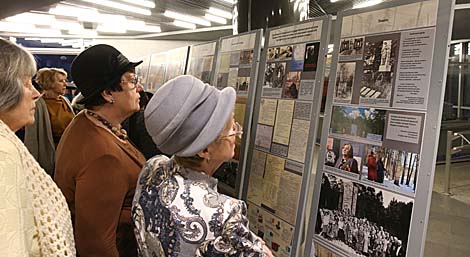Press releases
Belarusian WW2 museum’s exhibition marks 75th anniversary of Ozarichi death camp liberation

MINSK, 20 March (BelTA) – A temporary exhibition timed to the 75th anniversary since the Ozarichi death camp was liberated has been opened in the Belarusian State Museum of History of the Great Patriotic War, BelTA has learned.
The exhibition is built around the museum’s collection of photos taken by military photographers on 18-19 March 1944. The pictures demonstrate the territory of the complex of death camps near the town of Ozarichi, the villages of Podosinnik and Dert. The pictures condemn the essence of fascism by showing dead prisoners of the camp, live ones being led out and given medical aid. Authentic photo captions made by the military photographers are available. The exhibition’s documentary part showcases frontline newspapers, leaflets, brochures, letters of thanks sent by the BSSR government to personnel of the 65th army for saving civilians from the Ozarichi death camp. The exhibition also presents recollections by former death camp prisoners and by army medics.
 Efforts of the Belarusian State Museum of History of the Great Patriotic War to examine the Ozarichi tragedy and the museum’s participation in lives of the former prisoners are also covered.
Efforts of the Belarusian State Museum of History of the Great Patriotic War to examine the Ozarichi tragedy and the museum’s participation in lives of the former prisoners are also covered.
Over 260 death camps and mass slaughter sites were created in Belarus by the occupying German troops during the Great Patriotic War of 1941-1945. The complex of Ozarichi death camps did not operate for a long time. But even several days of staying there left people with incurable diseases, physical injuries, and psychological traumas. “Many Belarusians lost their families in the Ozarichi hell,” recalled Anna Galinskaya, Deputy Director for Science of the Belarusian State Museum of History of the Great Patriotic War.
 The official reminded that the Nazi kept about 50,000 elderly people, kids, women, people with disabilities, and people with typhoid behind the razor wire. The German army tried to stop the advance of the Red Army with a barrier of live people and the propagation of typhus fever. The liberation of the prisoners began on 19 March 1944. The Soviet troops released 33,380 people from the complex of Ozarichi death camps, including 15,960 kids under 13 and 13,072 women. Not all of them lived long after liberation. People kept dying of typhus, freeze burns, dysentery, and fragmentation wounds. Many of them remained crippled for their entire life.
The official reminded that the Nazi kept about 50,000 elderly people, kids, women, people with disabilities, and people with typhoid behind the razor wire. The German army tried to stop the advance of the Red Army with a barrier of live people and the propagation of typhus fever. The liberation of the prisoners began on 19 March 1944. The Soviet troops released 33,380 people from the complex of Ozarichi death camps, including 15,960 kids under 13 and 13,072 women. Not all of them lived long after liberation. People kept dying of typhus, freeze burns, dysentery, and fragmentation wounds. Many of them remained crippled for their entire life.
According to the source, a small part of the photos on display were taken by the museum’s specialists in an expedition to the death camp site in the 1990s. “Our archives contain many letters from former prisoners of the Ozarichi death camp. Every letter is filled with pain and suffering of individual people, families, and entire villages. People recall how they were forced to move into the death camps, how those, who were dropping behind the shambling columns, were shot on the road, how they were dying in swamps, how they were burying their loved ones,” Anna Galinskaya said.
 The exhibition “Ozarichi: Tragedy of the peaceful population of Belarus” will stay open through 22 April.
The exhibition “Ozarichi: Tragedy of the peaceful population of Belarus” will stay open through 22 April.







 print version
print version make home page
make home page add to bookmarks
add to bookmarks

